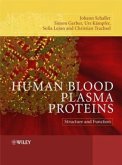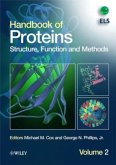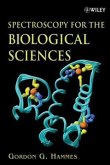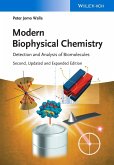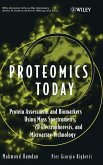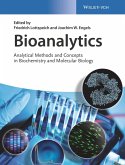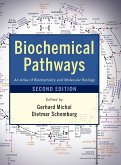Monolithic Silicas in Separation Science
Concepts, Syntheses, Characterization, Modeling and Applications
Eds.: Unger, Klaus K.; Tanaka, Nobuo; Machtejevas, Egidijus
Monolithic Silicas in Separation Science
Concepts, Syntheses, Characterization, Modeling and Applications
Eds.: Unger, Klaus K.; Tanaka, Nobuo; Machtejevas, Egidijus
- Gebundenes Buch
- Merkliste
- Auf die Merkliste
- Bewerten Bewerten
- Teilen
- Produkt teilen
- Produkterinnerung
- Produkterinnerung
Edited by the experts and pioneers in the field, this is the first monograph to cover the topic, containing the must-have information hitherto only scattered among journals. Clearly divided into sections on preparation, characterization and modeling, and applications, this is essential reading for chemists, chromatographers, analytical chemists, biochemists and biologists.
Andere Kunden interessierten sich auch für
![Human Blood Plasma Proteins Human Blood Plasma Proteins]() Johann SchallerHuman Blood Plasma Proteins243,99 €
Johann SchallerHuman Blood Plasma Proteins243,99 €![Handbook of Proteins Handbook of Proteins]() Handbook of Proteins675,99 €
Handbook of Proteins675,99 €![Spectroscopy for the Biological Sciences Spectroscopy for the Biological Sciences]() Gordon G. HammesSpectroscopy for the Biological Sciences109,99 €
Gordon G. HammesSpectroscopy for the Biological Sciences109,99 €![Modern Biophysical Chemistry Modern Biophysical Chemistry]() Peter Jomo WallaModern Biophysical Chemistry70,99 €
Peter Jomo WallaModern Biophysical Chemistry70,99 €![Proteomics Today Proteomics Today]() Mahmoud H HamdanProteomics Today190,99 €
Mahmoud H HamdanProteomics Today190,99 €![Bioanalytics Bioanalytics]() Friedrich LottspeichBioanalytics79,99 €
Friedrich LottspeichBioanalytics79,99 €![Biochemical Pathways 2e Biochemical Pathways 2e]() Gerhard MichalBiochemical Pathways 2e142,99 €
Gerhard MichalBiochemical Pathways 2e142,99 €-
-
-
Edited by the experts and pioneers in the field, this is the first monograph to cover the topic, containing the must-have information hitherto only scattered among journals.
Clearly divided into sections on preparation, characterization and modeling, and applications, this is essential reading for chemists, chromatographers, analytical chemists, biochemists and biologists.
Hinweis: Dieser Artikel kann nur an eine deutsche Lieferadresse ausgeliefert werden.
Clearly divided into sections on preparation, characterization and modeling, and applications, this is essential reading for chemists, chromatographers, analytical chemists, biochemists and biologists.
Hinweis: Dieser Artikel kann nur an eine deutsche Lieferadresse ausgeliefert werden.
Produktdetails
- Produktdetails
- Verlag: Wiley-VCH
- Artikelnr. des Verlages: 1132575 000
- 1. Auflage
- Seitenzahl: 344
- Erscheinungstermin: 14. Januar 2011
- Englisch
- Abmessung: 249mm x 182mm x 23mm
- Gewicht: 840g
- ISBN-13: 9783527325757
- ISBN-10: 3527325751
- Artikelnr.: 31187703
- Herstellerkennzeichnung
- Wiley VCH Verlag GmbH
- Boschstr. 12
- 69469 Weinheim
- &Co.KGaA
- +4962016060
- Verlag: Wiley-VCH
- Artikelnr. des Verlages: 1132575 000
- 1. Auflage
- Seitenzahl: 344
- Erscheinungstermin: 14. Januar 2011
- Englisch
- Abmessung: 249mm x 182mm x 23mm
- Gewicht: 840g
- ISBN-13: 9783527325757
- ISBN-10: 3527325751
- Artikelnr.: 31187703
- Herstellerkennzeichnung
- Wiley VCH Verlag GmbH
- Boschstr. 12
- 69469 Weinheim
- &Co.KGaA
- +4962016060
Nobuo Tanaka studied chemistry at Kyoto University, Japan. After his postdocs in the US at the Universities of Pennsylvania, Washington and Northeastern University, he came back to Kyoto, where he is Professor at the Institute of Technology. His research interests include development of chromatographic columns and stationary phases, separation of isotopes, isomers and environmental contaminants on solid surfaces. He is editor of Wileys Journal of Separation Science as well as others. He received several awards as the Environmental Award (1994), Award from the Society for Chromatographic Sciences (1998), the Jubilee Silver Medal of the UK Chromatographic Society (2002) and the Japan Society for Analytical Chemistry Award (2004).
Klaus K. Unger started his research career at the Technical University of Darmstadt, Germany, before he moved to the University of Mainz, Germany. He is one of the pioneers in the development of silica based materials for HPLC. He published many scientific papers as well as successful books.
Egidijus Machtejevas is postdoc in the research group of Klaus K. Unger and co-authored already many research papers.
Klaus K. Unger started his research career at the Technical University of Darmstadt, Germany, before he moved to the University of Mainz, Germany. He is one of the pioneers in the development of silica based materials for HPLC. He published many scientific papers as well as successful books.
Egidijus Machtejevas is postdoc in the research group of Klaus K. Unger and co-authored already many research papers.
Preface
THE BASIC IDEA AND THE DRIVERS
Definitions
Monoliths as Heterogeneous Catalysts
Monoliths in Chromatographic Separations
Conclusion and Perspectives
PART I: Preparation
SYNTHESIS CONCEPTS AND PREPARATION OF SILICA MONOLITHS
Introduction
Background and Concepts
Synthesis of Silica Monoliths
Monolithic Columns Prepared in the Laboratory
PREPARATION AND PROPERTIES OF VARIOUS TYPES OF MONOLITHIC SILICA STATIONARY PHASES FOR REVERSED-PHASE, HYDROPHILIC INTERACTION, AND ION-EXCHANGE CHROMATOGRAPHY BASED ON POLYMER-COATED MATERIALS
Stationary Phases for Reversed-Phase Chromatography
Stationary Phases for Hydrophilic-Interaction Chromatography Separations
Stationary Phases for Ion-Exchange Separations
Advantages of Polymer-Coated Monolithic Silica Columns
PART II: Characterization and Modeling
CHARACTERIZATION OF THE PORE STRUCTURE OF MONOLITHIC SILICAS
Monolithic Silicas
General Aspects Describing Porous Materials
Characterization Methods of the Pore Structure of Monolithic Silicas
Comparison of the Silica Monolith Mesopore-Characterization Data
Comparison of the Silica Monolith Flow-Through Pore-Characterization Data
MICROSCOPIC CHARACTERIZATIONS
Introduction
Preparation of Macroporous Silica Monolith
Laser Scanning Confocal Microscope Observation
Image Processing
Fundamental Parameters
Three-Dimensional Observation of Deformations in Confined Geometry
MODELING CHROMATOGRAPHIC BAND BROADENING IN MONOLITHIC COLUMNS
Introduction
The General Plate-Height Model
User of the General Plate-Height Model to Predict Band Broadening in TSM Structures
Conclusion
COMPARISON OF THE PERFORMANCE OF PARTICLE-PACKED AND MONOLITHIC COLUMNS IN HIGH-PERFORMANCE LIQUID CHROMATOGRAPHY
Introduction
Basic Columns Properties
Comparison of the Through-Pore Structures and Related Properties
Thermodynamic Properties
Kinetic Properties and Column Efficiency
Conclusions
PART III: Applications
QUANTITATIVE STRUCTURE-RETENTION RELATIONSHIPS IN STUDIES OF MONOLITHIC MATERIALS
Fundamentals of Quantitative Structure-Retention Relationships (QSSR)
Quantitative Relationships between Analyte Hydrophobicity and Retention on Monolithic Columns
QSSR Based on Structural Descriptors from Calculation Chemistry
LSER on Monolithic Columns
Concluding Remarks
PERFORMANCE OF SILICA MONOLITHS FOR BASIC COMPOUNDS. SILANOL ACTIVITY
Introduction
Reproducibility of Commercial Monoliths for Analysis of Bases
Activity of Monoliths towards Basic Solutes
Contribution of Overload to Peak Shapes of Basic Solutes
Van Deemter Plots for Commercial Monoliths
Performance of Hybrid Capillary Silica Monoliths for Basic Compounds
QUALITY CONTROL OF DRUGS
Introduction
Analysis of Pharmaceutics
Natural Products Analysis
Analysis Speed and Performance
Method Transfer
Separation of Complex Mixtures
Monolithic Derivatives and Versatile Application
Summary and Conclusions
MONOLITHIC STATIONARY PHASES FOR FAST ION CHROMATOGRAPHY
Fast Ion Chromatography
Historical Development of Fast Ion Chromatography
3 Advantages of the Bimodal Porous Structure of the Silica Monolith Matrix
Type and Properties of Silica Monolithic Columns Used in IC
Modification of Silica Monoliths for IC Separations
Operational Parameters
Analytical Applications
Future Work
MONOLITHIC CHIRAL STATIONARY PHASES FOR LIQUID-PHASE ENANTIOSEPARATION TECHNIQUES
Introduction
Organic Monolithic Materials for the Separation of Enantiomers
Silica-Based Monolithic Materials for the Separation of Enantiomers
Summary of the Present State-of-the-Art and Problems to be Solved in the Future
HIGH-SPEED AND HIGH-EFFICIENCY SEPARATIONS BY UTILIZING MONOLITHIC SILICA CAPILLARY COLUMNS
Introduction
Preparation of Monolithic Silica Capillary Columns
Properties of Monolithic Silica Capillary Columns
Monolithic Silica Capillary Columns for High-Efficiency Separations
Monolithic Silica Capillary Columns for High-Speed Separations
Future Considerations
SILICA MONOLITHIC COLUMNS AND MASS SPECTROMETRY
Introduction
Offline Chromatography, LC MALDI MS
Online ESI LC/MS/MS for Proteomics and Selected Reaction Monitoring (SRM)
Online Reactors and Affinity Columns Coupled to Mass Spectrometry
Conclusion
SILICA MONOLITHS FOR SMALL-SCALE PURIFICATION OF DRUG-DISCOVERY COMPOUNDS
Introduction
Instrumental and Operating Considerations
Preparative Separations and Sample Loading
Purification of Drug-Discovery Compounds
Conclusions
MONOLITHIC SILICA COLUMNS IN MULTIDIMENSIONAL LC-MS FOR PROTEOMICS AND PEPTIDOMICS
Introduction
Liquid Chromatography as a Tool Box for Proteomics
Selectivity of Columns for MD-LC
Dimensions of Columns in MD-LC
Monolithic Silica Columns
Applications of Monolithic Silica in Proteomics - A Brief Survey
Summary and Conclusions
SILICA MONOLITHS IN SOLID-PHASE EXTRACTION AND SOLID-PHASE MICROEXTRACTION
Introduction
Extraction Process
Extraction Platforms
Applications
Conclusion and Outlook
THE BASIC IDEA AND THE DRIVERS
Definitions
Monoliths as Heterogeneous Catalysts
Monoliths in Chromatographic Separations
Conclusion and Perspectives
PART I: Preparation
SYNTHESIS CONCEPTS AND PREPARATION OF SILICA MONOLITHS
Introduction
Background and Concepts
Synthesis of Silica Monoliths
Monolithic Columns Prepared in the Laboratory
PREPARATION AND PROPERTIES OF VARIOUS TYPES OF MONOLITHIC SILICA STATIONARY PHASES FOR REVERSED-PHASE, HYDROPHILIC INTERACTION, AND ION-EXCHANGE CHROMATOGRAPHY BASED ON POLYMER-COATED MATERIALS
Stationary Phases for Reversed-Phase Chromatography
Stationary Phases for Hydrophilic-Interaction Chromatography Separations
Stationary Phases for Ion-Exchange Separations
Advantages of Polymer-Coated Monolithic Silica Columns
PART II: Characterization and Modeling
CHARACTERIZATION OF THE PORE STRUCTURE OF MONOLITHIC SILICAS
Monolithic Silicas
General Aspects Describing Porous Materials
Characterization Methods of the Pore Structure of Monolithic Silicas
Comparison of the Silica Monolith Mesopore-Characterization Data
Comparison of the Silica Monolith Flow-Through Pore-Characterization Data
MICROSCOPIC CHARACTERIZATIONS
Introduction
Preparation of Macroporous Silica Monolith
Laser Scanning Confocal Microscope Observation
Image Processing
Fundamental Parameters
Three-Dimensional Observation of Deformations in Confined Geometry
MODELING CHROMATOGRAPHIC BAND BROADENING IN MONOLITHIC COLUMNS
Introduction
The General Plate-Height Model
User of the General Plate-Height Model to Predict Band Broadening in TSM Structures
Conclusion
COMPARISON OF THE PERFORMANCE OF PARTICLE-PACKED AND MONOLITHIC COLUMNS IN HIGH-PERFORMANCE LIQUID CHROMATOGRAPHY
Introduction
Basic Columns Properties
Comparison of the Through-Pore Structures and Related Properties
Thermodynamic Properties
Kinetic Properties and Column Efficiency
Conclusions
PART III: Applications
QUANTITATIVE STRUCTURE-RETENTION RELATIONSHIPS IN STUDIES OF MONOLITHIC MATERIALS
Fundamentals of Quantitative Structure-Retention Relationships (QSSR)
Quantitative Relationships between Analyte Hydrophobicity and Retention on Monolithic Columns
QSSR Based on Structural Descriptors from Calculation Chemistry
LSER on Monolithic Columns
Concluding Remarks
PERFORMANCE OF SILICA MONOLITHS FOR BASIC COMPOUNDS. SILANOL ACTIVITY
Introduction
Reproducibility of Commercial Monoliths for Analysis of Bases
Activity of Monoliths towards Basic Solutes
Contribution of Overload to Peak Shapes of Basic Solutes
Van Deemter Plots for Commercial Monoliths
Performance of Hybrid Capillary Silica Monoliths for Basic Compounds
QUALITY CONTROL OF DRUGS
Introduction
Analysis of Pharmaceutics
Natural Products Analysis
Analysis Speed and Performance
Method Transfer
Separation of Complex Mixtures
Monolithic Derivatives and Versatile Application
Summary and Conclusions
MONOLITHIC STATIONARY PHASES FOR FAST ION CHROMATOGRAPHY
Fast Ion Chromatography
Historical Development of Fast Ion Chromatography
3 Advantages of the Bimodal Porous Structure of the Silica Monolith Matrix
Type and Properties of Silica Monolithic Columns Used in IC
Modification of Silica Monoliths for IC Separations
Operational Parameters
Analytical Applications
Future Work
MONOLITHIC CHIRAL STATIONARY PHASES FOR LIQUID-PHASE ENANTIOSEPARATION TECHNIQUES
Introduction
Organic Monolithic Materials for the Separation of Enantiomers
Silica-Based Monolithic Materials for the Separation of Enantiomers
Summary of the Present State-of-the-Art and Problems to be Solved in the Future
HIGH-SPEED AND HIGH-EFFICIENCY SEPARATIONS BY UTILIZING MONOLITHIC SILICA CAPILLARY COLUMNS
Introduction
Preparation of Monolithic Silica Capillary Columns
Properties of Monolithic Silica Capillary Columns
Monolithic Silica Capillary Columns for High-Efficiency Separations
Monolithic Silica Capillary Columns for High-Speed Separations
Future Considerations
SILICA MONOLITHIC COLUMNS AND MASS SPECTROMETRY
Introduction
Offline Chromatography, LC MALDI MS
Online ESI LC/MS/MS for Proteomics and Selected Reaction Monitoring (SRM)
Online Reactors and Affinity Columns Coupled to Mass Spectrometry
Conclusion
SILICA MONOLITHS FOR SMALL-SCALE PURIFICATION OF DRUG-DISCOVERY COMPOUNDS
Introduction
Instrumental and Operating Considerations
Preparative Separations and Sample Loading
Purification of Drug-Discovery Compounds
Conclusions
MONOLITHIC SILICA COLUMNS IN MULTIDIMENSIONAL LC-MS FOR PROTEOMICS AND PEPTIDOMICS
Introduction
Liquid Chromatography as a Tool Box for Proteomics
Selectivity of Columns for MD-LC
Dimensions of Columns in MD-LC
Monolithic Silica Columns
Applications of Monolithic Silica in Proteomics - A Brief Survey
Summary and Conclusions
SILICA MONOLITHS IN SOLID-PHASE EXTRACTION AND SOLID-PHASE MICROEXTRACTION
Introduction
Extraction Process
Extraction Platforms
Applications
Conclusion and Outlook
Preface
THE BASIC IDEA AND THE DRIVERS
Definitions
Monoliths as Heterogeneous Catalysts
Monoliths in Chromatographic Separations
Conclusion and Perspectives
PART I: Preparation
SYNTHESIS CONCEPTS AND PREPARATION OF SILICA MONOLITHS
Introduction
Background and Concepts
Synthesis of Silica Monoliths
Monolithic Columns Prepared in the Laboratory
PREPARATION AND PROPERTIES OF VARIOUS TYPES OF MONOLITHIC SILICA STATIONARY PHASES FOR REVERSED-PHASE, HYDROPHILIC INTERACTION, AND ION-EXCHANGE CHROMATOGRAPHY BASED ON POLYMER-COATED MATERIALS
Stationary Phases for Reversed-Phase Chromatography
Stationary Phases for Hydrophilic-Interaction Chromatography Separations
Stationary Phases for Ion-Exchange Separations
Advantages of Polymer-Coated Monolithic Silica Columns
PART II: Characterization and Modeling
CHARACTERIZATION OF THE PORE STRUCTURE OF MONOLITHIC SILICAS
Monolithic Silicas
General Aspects Describing Porous Materials
Characterization Methods of the Pore Structure of Monolithic Silicas
Comparison of the Silica Monolith Mesopore-Characterization Data
Comparison of the Silica Monolith Flow-Through Pore-Characterization Data
MICROSCOPIC CHARACTERIZATIONS
Introduction
Preparation of Macroporous Silica Monolith
Laser Scanning Confocal Microscope Observation
Image Processing
Fundamental Parameters
Three-Dimensional Observation of Deformations in Confined Geometry
MODELING CHROMATOGRAPHIC BAND BROADENING IN MONOLITHIC COLUMNS
Introduction
The General Plate-Height Model
User of the General Plate-Height Model to Predict Band Broadening in TSM Structures
Conclusion
COMPARISON OF THE PERFORMANCE OF PARTICLE-PACKED AND MONOLITHIC COLUMNS IN HIGH-PERFORMANCE LIQUID CHROMATOGRAPHY
Introduction
Basic Columns Properties
Comparison of the Through-Pore Structures and Related Properties
Thermodynamic Properties
Kinetic Properties and Column Efficiency
Conclusions
PART III: Applications
QUANTITATIVE STRUCTURE-RETENTION RELATIONSHIPS IN STUDIES OF MONOLITHIC MATERIALS
Fundamentals of Quantitative Structure-Retention Relationships (QSSR)
Quantitative Relationships between Analyte Hydrophobicity and Retention on Monolithic Columns
QSSR Based on Structural Descriptors from Calculation Chemistry
LSER on Monolithic Columns
Concluding Remarks
PERFORMANCE OF SILICA MONOLITHS FOR BASIC COMPOUNDS. SILANOL ACTIVITY
Introduction
Reproducibility of Commercial Monoliths for Analysis of Bases
Activity of Monoliths towards Basic Solutes
Contribution of Overload to Peak Shapes of Basic Solutes
Van Deemter Plots for Commercial Monoliths
Performance of Hybrid Capillary Silica Monoliths for Basic Compounds
QUALITY CONTROL OF DRUGS
Introduction
Analysis of Pharmaceutics
Natural Products Analysis
Analysis Speed and Performance
Method Transfer
Separation of Complex Mixtures
Monolithic Derivatives and Versatile Application
Summary and Conclusions
MONOLITHIC STATIONARY PHASES FOR FAST ION CHROMATOGRAPHY
Fast Ion Chromatography
Historical Development of Fast Ion Chromatography
3 Advantages of the Bimodal Porous Structure of the Silica Monolith Matrix
Type and Properties of Silica Monolithic Columns Used in IC
Modification of Silica Monoliths for IC Separations
Operational Parameters
Analytical Applications
Future Work
MONOLITHIC CHIRAL STATIONARY PHASES FOR LIQUID-PHASE ENANTIOSEPARATION TECHNIQUES
Introduction
Organic Monolithic Materials for the Separation of Enantiomers
Silica-Based Monolithic Materials for the Separation of Enantiomers
Summary of the Present State-of-the-Art and Problems to be Solved in the Future
HIGH-SPEED AND HIGH-EFFICIENCY SEPARATIONS BY UTILIZING MONOLITHIC SILICA CAPILLARY COLUMNS
Introduction
Preparation of Monolithic Silica Capillary Columns
Properties of Monolithic Silica Capillary Columns
Monolithic Silica Capillary Columns for High-Efficiency Separations
Monolithic Silica Capillary Columns for High-Speed Separations
Future Considerations
SILICA MONOLITHIC COLUMNS AND MASS SPECTROMETRY
Introduction
Offline Chromatography, LC MALDI MS
Online ESI LC/MS/MS for Proteomics and Selected Reaction Monitoring (SRM)
Online Reactors and Affinity Columns Coupled to Mass Spectrometry
Conclusion
SILICA MONOLITHS FOR SMALL-SCALE PURIFICATION OF DRUG-DISCOVERY COMPOUNDS
Introduction
Instrumental and Operating Considerations
Preparative Separations and Sample Loading
Purification of Drug-Discovery Compounds
Conclusions
MONOLITHIC SILICA COLUMNS IN MULTIDIMENSIONAL LC-MS FOR PROTEOMICS AND PEPTIDOMICS
Introduction
Liquid Chromatography as a Tool Box for Proteomics
Selectivity of Columns for MD-LC
Dimensions of Columns in MD-LC
Monolithic Silica Columns
Applications of Monolithic Silica in Proteomics - A Brief Survey
Summary and Conclusions
SILICA MONOLITHS IN SOLID-PHASE EXTRACTION AND SOLID-PHASE MICROEXTRACTION
Introduction
Extraction Process
Extraction Platforms
Applications
Conclusion and Outlook
THE BASIC IDEA AND THE DRIVERS
Definitions
Monoliths as Heterogeneous Catalysts
Monoliths in Chromatographic Separations
Conclusion and Perspectives
PART I: Preparation
SYNTHESIS CONCEPTS AND PREPARATION OF SILICA MONOLITHS
Introduction
Background and Concepts
Synthesis of Silica Monoliths
Monolithic Columns Prepared in the Laboratory
PREPARATION AND PROPERTIES OF VARIOUS TYPES OF MONOLITHIC SILICA STATIONARY PHASES FOR REVERSED-PHASE, HYDROPHILIC INTERACTION, AND ION-EXCHANGE CHROMATOGRAPHY BASED ON POLYMER-COATED MATERIALS
Stationary Phases for Reversed-Phase Chromatography
Stationary Phases for Hydrophilic-Interaction Chromatography Separations
Stationary Phases for Ion-Exchange Separations
Advantages of Polymer-Coated Monolithic Silica Columns
PART II: Characterization and Modeling
CHARACTERIZATION OF THE PORE STRUCTURE OF MONOLITHIC SILICAS
Monolithic Silicas
General Aspects Describing Porous Materials
Characterization Methods of the Pore Structure of Monolithic Silicas
Comparison of the Silica Monolith Mesopore-Characterization Data
Comparison of the Silica Monolith Flow-Through Pore-Characterization Data
MICROSCOPIC CHARACTERIZATIONS
Introduction
Preparation of Macroporous Silica Monolith
Laser Scanning Confocal Microscope Observation
Image Processing
Fundamental Parameters
Three-Dimensional Observation of Deformations in Confined Geometry
MODELING CHROMATOGRAPHIC BAND BROADENING IN MONOLITHIC COLUMNS
Introduction
The General Plate-Height Model
User of the General Plate-Height Model to Predict Band Broadening in TSM Structures
Conclusion
COMPARISON OF THE PERFORMANCE OF PARTICLE-PACKED AND MONOLITHIC COLUMNS IN HIGH-PERFORMANCE LIQUID CHROMATOGRAPHY
Introduction
Basic Columns Properties
Comparison of the Through-Pore Structures and Related Properties
Thermodynamic Properties
Kinetic Properties and Column Efficiency
Conclusions
PART III: Applications
QUANTITATIVE STRUCTURE-RETENTION RELATIONSHIPS IN STUDIES OF MONOLITHIC MATERIALS
Fundamentals of Quantitative Structure-Retention Relationships (QSSR)
Quantitative Relationships between Analyte Hydrophobicity and Retention on Monolithic Columns
QSSR Based on Structural Descriptors from Calculation Chemistry
LSER on Monolithic Columns
Concluding Remarks
PERFORMANCE OF SILICA MONOLITHS FOR BASIC COMPOUNDS. SILANOL ACTIVITY
Introduction
Reproducibility of Commercial Monoliths for Analysis of Bases
Activity of Monoliths towards Basic Solutes
Contribution of Overload to Peak Shapes of Basic Solutes
Van Deemter Plots for Commercial Monoliths
Performance of Hybrid Capillary Silica Monoliths for Basic Compounds
QUALITY CONTROL OF DRUGS
Introduction
Analysis of Pharmaceutics
Natural Products Analysis
Analysis Speed and Performance
Method Transfer
Separation of Complex Mixtures
Monolithic Derivatives and Versatile Application
Summary and Conclusions
MONOLITHIC STATIONARY PHASES FOR FAST ION CHROMATOGRAPHY
Fast Ion Chromatography
Historical Development of Fast Ion Chromatography
3 Advantages of the Bimodal Porous Structure of the Silica Monolith Matrix
Type and Properties of Silica Monolithic Columns Used in IC
Modification of Silica Monoliths for IC Separations
Operational Parameters
Analytical Applications
Future Work
MONOLITHIC CHIRAL STATIONARY PHASES FOR LIQUID-PHASE ENANTIOSEPARATION TECHNIQUES
Introduction
Organic Monolithic Materials for the Separation of Enantiomers
Silica-Based Monolithic Materials for the Separation of Enantiomers
Summary of the Present State-of-the-Art and Problems to be Solved in the Future
HIGH-SPEED AND HIGH-EFFICIENCY SEPARATIONS BY UTILIZING MONOLITHIC SILICA CAPILLARY COLUMNS
Introduction
Preparation of Monolithic Silica Capillary Columns
Properties of Monolithic Silica Capillary Columns
Monolithic Silica Capillary Columns for High-Efficiency Separations
Monolithic Silica Capillary Columns for High-Speed Separations
Future Considerations
SILICA MONOLITHIC COLUMNS AND MASS SPECTROMETRY
Introduction
Offline Chromatography, LC MALDI MS
Online ESI LC/MS/MS for Proteomics and Selected Reaction Monitoring (SRM)
Online Reactors and Affinity Columns Coupled to Mass Spectrometry
Conclusion
SILICA MONOLITHS FOR SMALL-SCALE PURIFICATION OF DRUG-DISCOVERY COMPOUNDS
Introduction
Instrumental and Operating Considerations
Preparative Separations and Sample Loading
Purification of Drug-Discovery Compounds
Conclusions
MONOLITHIC SILICA COLUMNS IN MULTIDIMENSIONAL LC-MS FOR PROTEOMICS AND PEPTIDOMICS
Introduction
Liquid Chromatography as a Tool Box for Proteomics
Selectivity of Columns for MD-LC
Dimensions of Columns in MD-LC
Monolithic Silica Columns
Applications of Monolithic Silica in Proteomics - A Brief Survey
Summary and Conclusions
SILICA MONOLITHS IN SOLID-PHASE EXTRACTION AND SOLID-PHASE MICROEXTRACTION
Introduction
Extraction Process
Extraction Platforms
Applications
Conclusion and Outlook


